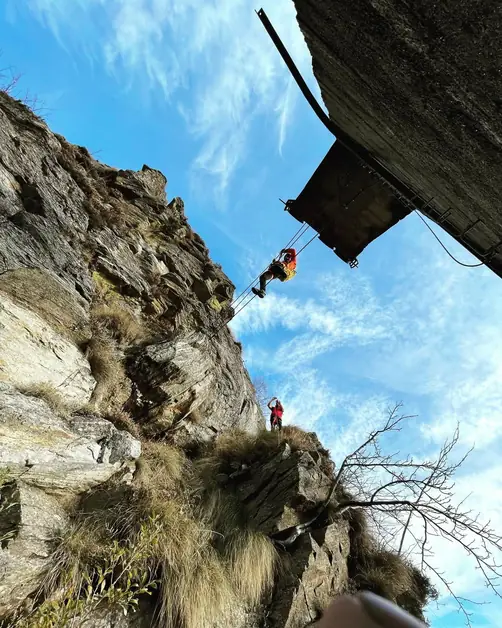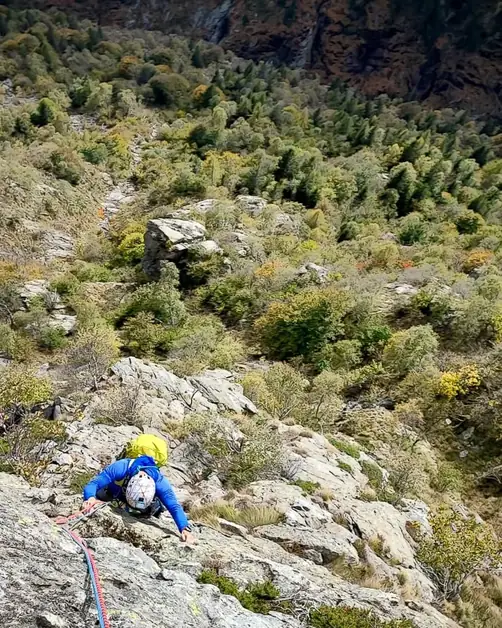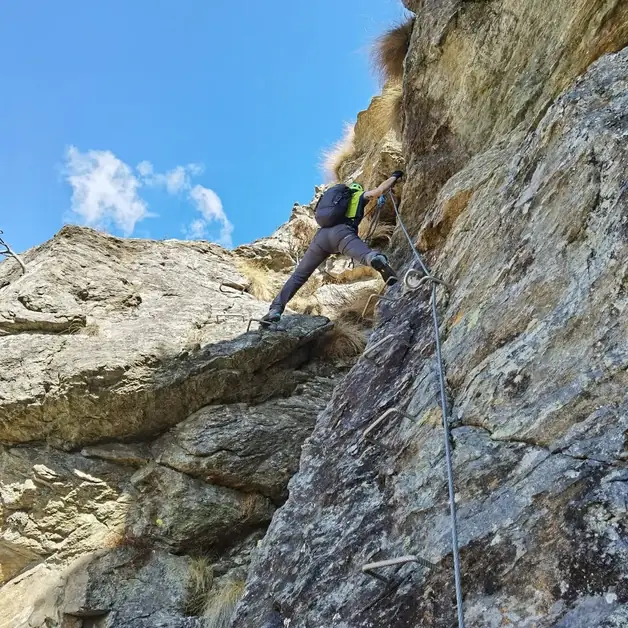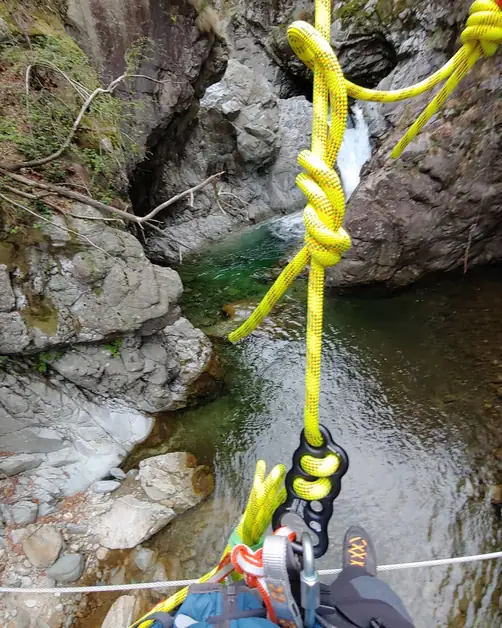Nito Staich Ferrata a Biella an unforgettable adventure
The Nito Staich Ferrata offers a unique experience among nature and adventure.

Where is the Nito Staich Ferrata and why is it so famous?
The Nito Staich Ferrata is located in Valle Elvo, a few kilometers from Biella, in Piedmont. It is one of the most well-known and loved ferratas in the Biella area, thanks to its panoramic position and the variety of passages it offers. It develops along the walls of Monte Fenera, near Bagneri, a charming hamlet nestled among beech and chestnut woods. The name of the ferrata is dedicated to Nito Staich, a climber and instructor of the CAI of Biella, who has significantly contributed to the dissemination of climbing and mountain culture in this area. Over time, the ferrata has become a true reference point for hikers and mountain enthusiasts from northern Italy, but also for tourists who want to try an adrenaline-pumping experience in total safety.
What is the difficulty of the Nito Staich Ferrata?
The Nito Staich Ferrata is classified as medium difficulty (D), making it suitable for those with at least some experience with ferrata routes. The path features vertical and slightly overhanging sections, but also quieter sections where it is possible to rest and enjoy the view. The overall elevation gain is about 300 meters, with an average travel time ranging from 1.5 to 2 hours, depending on the level of training. Although it is not among the most challenging ferratas in Piedmont, it still requires good physical condition, absence of vertigo, and appropriate equipment: ferrata kit with a shock absorber, harness and helmet, ferrata gloves, hiking boots with rigid soles or alpine trekking shoes.
How do you reach the Nito Staich Ferrata?
To reach the ferrata, you usually start from Sordevolo, a small town located about 10 km from Biella. From there, you follow the road leading to Bagneri, a very picturesque alpine hamlet and ideal starting point. Near the village's small church, there is a small parking area, and from there you take the marked trail that leads to the start of the ferrata. The approach takes about 30-40 minutes, crossing woods and scenic trail sections. During the ascent, the view of Valle Elvo, Monte Mucrone, and Oasi Zegna is spectacular, especially on clear days.
How is the Nito Staich Ferrata structured?
The route is well equipped with steel cables, sturdy steps, and rungs. The ferrata is divided into three main sections: 1. First part (vertical approach) – an initial stretch on an inclined slab that gradually introduces you to the wall. 2. Central section (more technical) – some vertical passages and a suspended traverse, very panoramic, where concentration is required. 3. Final part (ridge and exit) – the path becomes gentler, and you reach a natural terrace from which you can admire the view of the Biella plain. During the route, you also encounter a Tibetan bridge, an element that makes the ascent even more exciting. The entire route is well maintained by CAI Biella, and safety is always a top priority.
What is the feeling of facing the Nito Staich Ferrata?
The Nito Staich Ferrata is an experience that combines adrenaline and scenic beauty. From the first few meters, you feel a sense of freedom and connection with the mountain. The walls are exposed but never extreme, and the rock offers excellent grip. Those who traverse it experience the unique sensation of walking suspended between sky and valley, with a panorama that gradually opens up as you climb. For many hikers, the Nito Staich represents the perfect ferrata to begin exploring the vertical world: challenging enough, but always safe and rewarding.
When is it recommended to do the Nito Staich Ferrata?
The ideal time to tackle it is from April to October, avoiding rainy days or after storms, as the rock can become slippery. In spring and autumn, the temperatures are perfect, and the colors of the woods make the landscape spectacular. In summer, it is better to start early in the morning to avoid the heat and enjoy a softer light.
What to see around Biella after the ferrata?
After completing the ferrata, it is worth taking some time to discover the Biella area, rich in culture, nature, and authentic flavors. Here are some must-see destinations: Sanctuary of Oropa, one of the most important Marian sanctuaries in Italy, declared a UNESCO World Heritage Site. Bagneri, a stone hamlet with perfectly preserved Walser houses, ideal for a walk in the silence of the mountains. Oasi Zegna, a protected natural area with trails, panoramas, and paths for trekking and mountain biking. Biella Piazzo, the medieval historic center of the city, with historic buildings and charming views.
Where to sleep near the Nito Staich Ferrata?
There are numerous options for accommodation, depending on your needs: Refuge Savoia di Oropa: an excellent base for excursions and climbing. Agriturismo La Burcina, near the Burcina Park, with Piedmontese cuisine and cozy rooms. Hotel Augustus Biella, convenient for those who prefer to stay in the city. B&B Bagneri or Sordevolo, perfect for those who want to experience the authentic atmosphere of the Biella hamlets.
What to do in the evening after the ferrata?
After an intense day, it is time to relax and enjoy the local cuisine. In Biella and nearby towns, there are many typical taverns and trattorias where you can taste dishes such as: polenta concia, rich in mountain cheeses; tajarin with butter and sage; braised beef in Nebbiolo; cheeses from the Biella valleys such as maccagno and toma. Those who enjoy quiet evenings can stroll through the historic center of Biella, with its welcoming venues and wine bars where you can taste local wines. For those who desire a more mountain atmosphere, an evening in a refuge under the stars is a memorable experience.
What other activities can be done in the Biella area besides the Nito Staich Ferrata?
Biella and its valleys are a true paradise for outdoor enthusiasts. In addition to the ferrata, you can practice: trekking to Monte Mucrone or Monte Camino, sport climbing on numerous crags, mountain biking and e-biking along the paths of Oasi Zegna, snowshoeing and cross-country skiing in winter. Even those who do not practice sports will find unique experiences: craftsmanship, historic villages, wool museums, and breathtaking views that tell the story of an authentic mountain.
Why is the Nito Staich Ferrata a must-see for those visiting Biella?
Because it combines nature, adventure, and local history. It is an experience that allows you to live the mountain as protagonists, breathe pure air, and discover one of the most beautiful and least crowded corners of Piedmont. The Nito Staich Ferrata represents the very spirit of the Biella Prealps: authenticity, passion, and silence.


